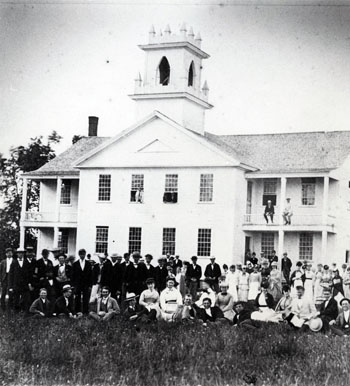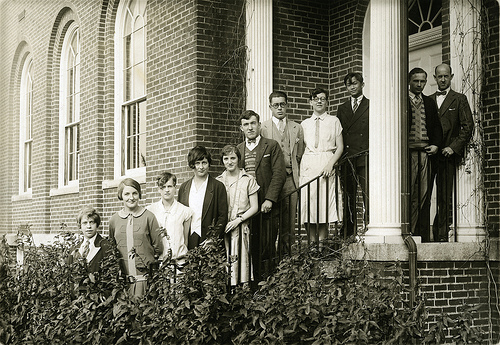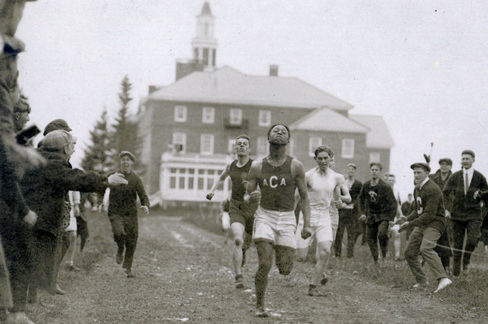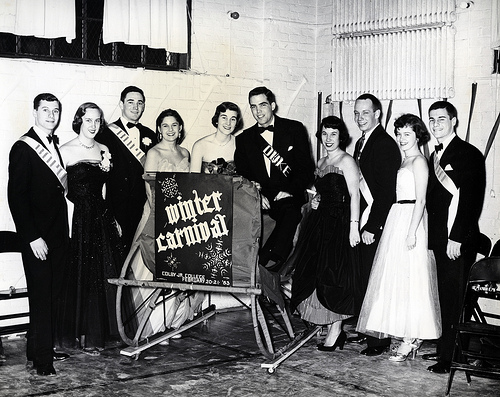
175 Years of Teaching and Learning
by Kelli Bogan, College Archivist
The school we know as Colby-Sawyer College has had many other names and identities in its 175-year history. It began as New London Academy and evolved into the New London Literary and Scientific Institute, Colby Academy, Colby Junior College and Colby College - New Hampshire before settling into its current identity as a comprehensive coeducational college.
Across the centuries of changing identities, this institution of teaching and learning has had a single educational philosophy that has endured: A belief in the potential of each student and the power of a student-centered education in the liberal arts and sciences to prepare them for productive careers and rewarding lives.
This, along with a strong attachment to their home away-from-home on a windy hill in New London, N.H., is the common thread that runs through students' experiences, whether they attended Colby Academy in the 1880s, Colby Junior College in the 1930s, or Colby- Sawyer College today.
The Academic Experience
In the academy days, just as it is at Colby-Sawyer College today, student life was characterized by small classes and close relationships with the faculty. Students could choose from three core curriculums, the first of which was the College Preparatory, or Classical Course, that prepared them to meet the entrance requirements of New England colleges by concentrating on Greek, Latin and mathematics. The Normal Course prepared students for the teaching profession and qualified them to teach in local schools. The final specialization, the Ladies' Collegiate Course, offered the most varied curriculum and gave students opportunities to study mathematics, science, English, religion, Italian, ancient history and government. Despite its name, this curriculum was not restricted to female students.
Settled deep in the woods and foothills of New Hampshire, the small town of New London may not seem like a prime destination for study abroad, yet Colby Academy hosted international students beginning in 1891 and has offered many programs over the years to connect its students with the larger world. In the academy days, students came from as far west as California, as far east as Nova Scotia, as far north as Montreal, and as far south as Mexico City. By the time it closed its doors, Colby Academy had also welcomed students from Uruguay, England, Puerto Rico and Greece.
In 1928, Colby Junior College took the rigorous curriculum of the academy days to the next level. Students' education was built on a broad foundation that included courses in art, music, literature and science as they worked toward associate degrees in areas such as Secretarial Science and Medical Technology. Even then, students had opportunities to complete internships and summer programs both in the United States and abroad. Colby Junior College students graduated after two years prepared to join the workforce or to continue their education.
International students continued to come to Colby Junior College, and our students also sought professional opportunities overseas. In the 1960s secretarial science students went to Kenya to teach skills to students at the University of Nairobi, and there were also opportunities to study abroad.
The same marriage of liberal arts and sciences programs with professional development continues in a Colby-Sawyer education today. Students in every major gain a solid foundation in the liberal arts, and a number of academic programs such as athletic training, business administration, environmental science and nursing prepare them to enter specific professional fields upon the completion of their baccalaureate degree. Internships are required for every academic major today, enabling students to acquire professional experience and skills in fields of study prior to their graduation. Today, Colby-Sawyer College has more international students than ever, nearly 140 students from 32 countries, and our students have opportunities to study or participate in field research programs abroad.
A Look at Student Life
Life outside of their studies was important to academy students and Colby Junior College students, just as it is for Colby-Sawyer students. Whether through athletics, clubs or individual pursuits with friends, our students have always been energetic and resourceful in pursuing their extracurricular activities. The specifics of their endeavors have changed over time, but the spirit of exploration, connection and growth has carried on from the academy days to the present day.

Clubs and Organizations
The largest diversions for academy students were literary societies, which offered the opportunity to write, debate and enjoy lively conversation. The largest men's societies were the Euphemian Society and the United Friends, which later merged to become the Philalethian Society.
Smaller men's groups included Epsilon Pi Delta and the Granite Debating Society. Women participated in the Ladies' Literary and Missionary Association or in the smaller D.G.V. Gesellschaft and the Euphorbian Society. Literary societies were essentially social organizations whose activities included debating topics of the day, writing essays and poems and collecting a library. These organizations are the precursors for many of the clubs and organizations that emerged at Colby Junior College and Colby-Sawyer College. Examples of literary pursuits that have arisen in later years include the Blue Quill and Solidus, an online literary magazine. Debates continue in the Student Government Association and departmental organizations like the Biology, History and Philosophy Clubs.
Music has also been an important part of our institutional history. The academy had student organized singing groups that faded in and out of fashion depending on the trends of the time. Music clubs arose with the start of the junior college, and music would become even more important at Colby Junior College with choir, glee club, orchestra and later, with the organization of the Buzzin' Dozen and the Monotones. Today, the musical tradition continues at the college with the Colby-Sawyer College Singers, a choir composed of college and area community members, and The Voices of Colby- Sawyer, a student-led gospel choir.
Written and photographic expressions are also honored Colby-Sawyer traditions. The first student newspaper, The Colby Voice, served as a local newspaper, school newspaper and literary magazine. The format and name of the student newspaper has changed over the years but other than a few dark years, a student newspaper has been published from 1889 until 2005. The current newspaper, The Colby-Sawyer Courier, became an online publication in 2011, a long way from the thick booklets of the academy days.
The other major publication was The Colbyan, the yearbook that documented the life of students on campus for nearly 100 years. Originated in 1918, The Colbyan was published until 2005. Although it is no longer in publication, students have since celebrated their classes in video yearbooks and in other electronic formats in keeping with the spirit of The Colbyan.

Sports and Athletics
In the early academy days, exercise for young men was limited to outdoor play and chores like working in the woodpile in winter and the garden in summer. In that era, young women playing baseball or basketball would have been shocking. But the Civil War brought with it two kinds of exercise: military drills and baseball. Baseball became popular in the army camps, and after the war the soldiers brought it back to villages across the country.
Eventually, the academy expanded beyond these two pursuits and the trustees authorized construction of a gymnasium. The first floor was intended as a dressing room, for Indian club practice and a bowling alley; the second floor was designed for the use of bars and for baseball practice. Polo and track athletics also became popular among the men, and croquet and tennis among the women. Later, organized sports at the academy included baseball, football, hockey, basketball and track for men and field hockey for women.
The formation of Colby Junior College brought an explosion of women's sports. Students joined the Athletic Association and played field hockey and basketball, with residence halls pitted against each other. Horseback riding was particularly popular, as it continues to be today at Colby-Sawyer.
For lighter recreation, a toboggan chute with a 20-foot high steel tower was erected in the rear of Colgate Hall. Organized sports went beyond field hockey to include cheerleading, skiing, volleyball, tennis, badminton and basketball. Students also were required to take a physical education class and many students enjoyed spending time outdoors cycling, skiing and snowshoeing.
When male students returned to Colby-Sawyer in 1990-1991, they brought with them soccer, basketball, baseball and track and field, many of the sports that were originally played by men at Colby Academy. The college now offers nine varsity sports for men. Women's sports have also continued to flourish, with 11 women's varsity sports including skiing, equestrian, lacrosse, volleyball and soccer. In addition to varsity and recreational sports, Colby-Sawyer offers club sports such as rugby, golf and floor hockey.

Traditions and Events
Some of the traditions and events that current Colby-Sawyer students enjoy today originated in the academy's earliest days. The best known is Mountain Day, the annual fall hike up Mt. Kearsarge, which may have begun as early as the 1850s. The first official account of the event was published in The Colby Voice in 1893. Enthusiasm for this old tradition was revived in the early years of Colby Junior College and continues to attract hundreds of Colby-Sawyer College community members every year. Other traditions, like Winter Carnival, have evolved but remain a part of the college's culture. Winter Carnival began at Colby Academy in the 1920s as a way to energize the student population during the long winter months. Winter Carnival has been held every February, with the exception of a brief hiatus in the early 1970s. The earliest carnivals included snowshoeing and skiing races as well as shows or films.
Colby Junior College took Winter Carnival to a whole new level with skiing, tobogganing, ice skating, dances, casino nights and even baseball games played on snowshoes. One of the biggest events of the carnival was the snow sculpture contest. Each residence hall would carefully craft a snow sculpture based on the year's theme.
Today, Winter Carnival continues in the spirit of its predecessors. The college still hosts a variety of activities including comedians, films and dances. In recent years, the college community has collaborated with New London to incorporate a Jack Frost dinner during which students and community alike can sample local fare while on skis and snowshoes.
Past to Present
As Colby-Sawyer celebrates its 175th anniversary, it is a time to explore and embrace our long and proud tradition of teaching and learning. Our history of constant evolution seems unsurprising, considering that the college once again finds itself in a period of rapid growth in student enrollment, the size of the faculty, academic programs and campus facilities. Our history has been one of continuous change—in response to our students' needs, to economic realities and to current trends in education.
As the college moves ahead, it is re-introducing itself with a new set of strategic themes and a bold new visual identity. And yet, our new direction stems in large part from the college's traditional strengths—in engaged learning, commitment to our environment, and interest in connecting to the larger world. Most importantly, the academy, the junior college and the baccalaureate college have built a tradition of excellence in teaching and learning, which revolves around and exists for our students' benefit.


